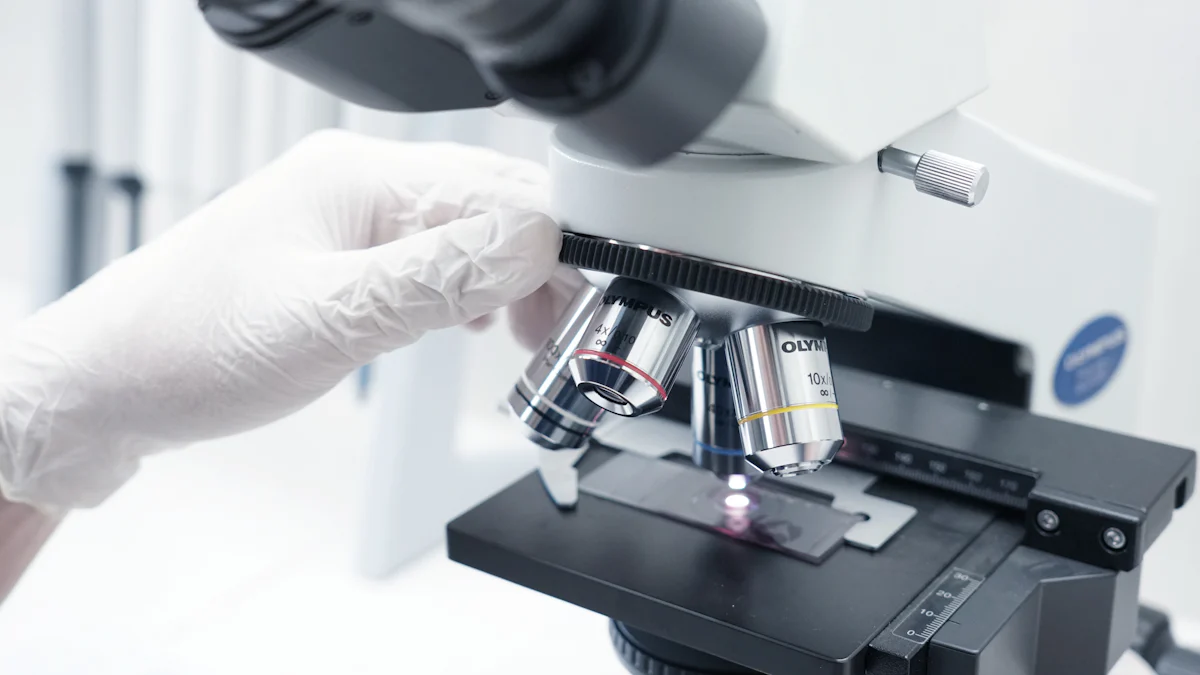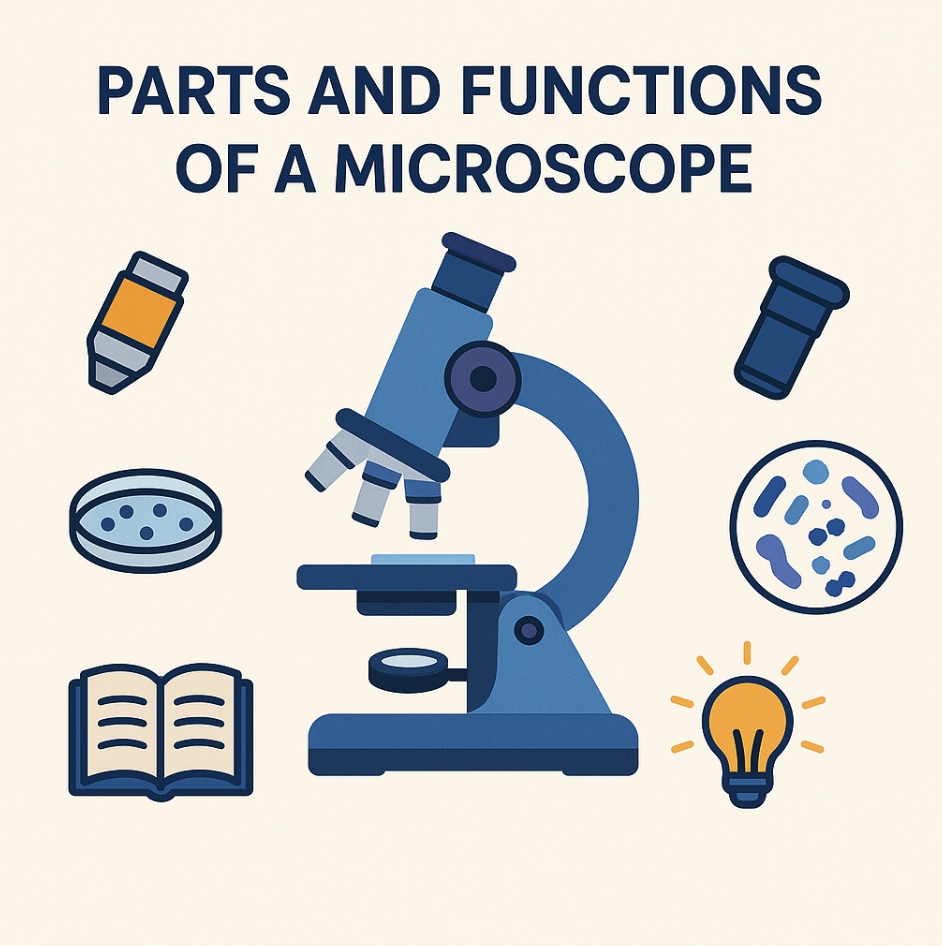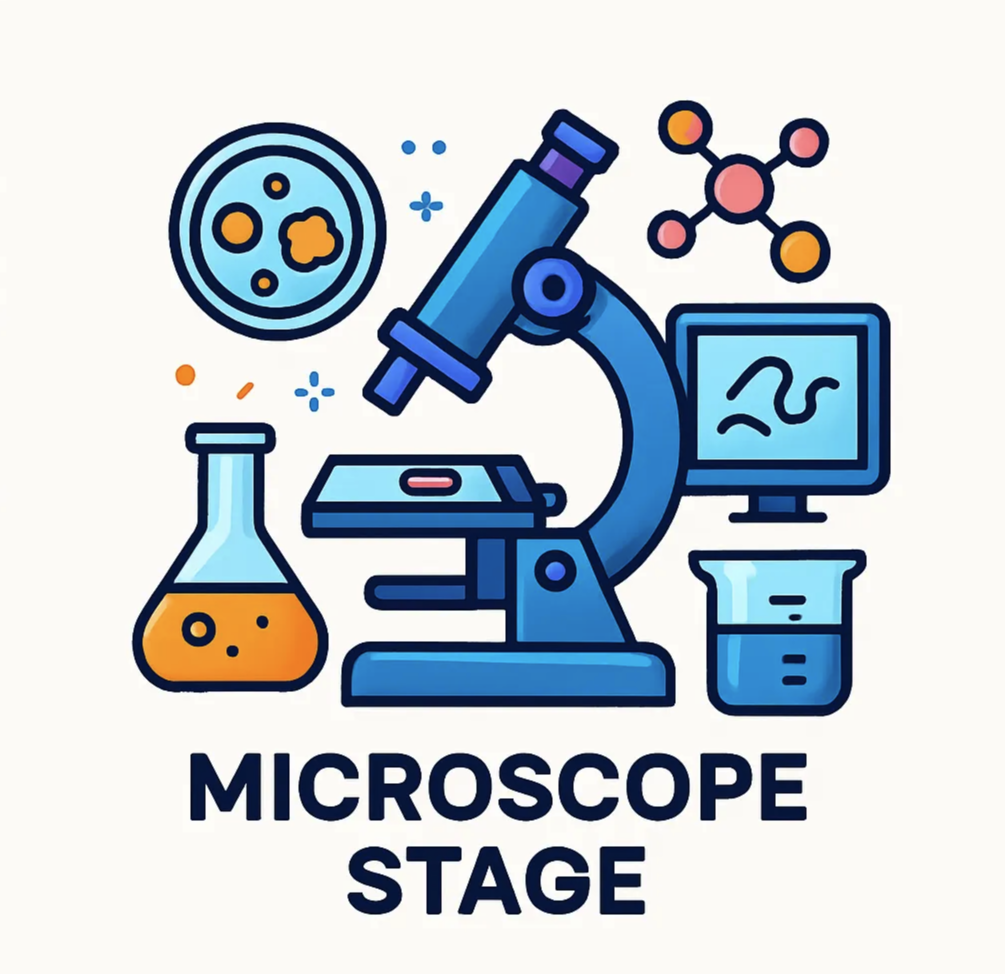
Like everyone else, I wondered how a compound microscope worked when I was first exposed to it. This powerful tool allows you to explore the microscopic world, revealing details invisible to the naked eye. A compound microscope magnifies objects using a series of lenses, making it the key ingredient for scientific research and education.
Once you understand how it works and what it can do, you’ll be able to make the most of it. It doesn’t matter if you’re using a USB microscope for kids or a traditional one; learning how to operate it can open up many exciting opportunities.
Get ready to discover the awesome features of this key tool and enhance your scientific explorations.
How Does It Work?
Basic Working Principle
Peering into a compound microscope lets you explore the intimate interaction between lenses and light. It uses several lenses to enlarge the specimen’s image. The main idea here is refraction, which happens when light bends while passing through different materials.
The objective lens, positioned close to the specimen, captures and magnifies the image. Then, the eyepiece lens further enlarges this image for your eyes. This dual-lens system allows you to see details that are otherwise invisible to the naked eye.
Overview of Optical Pathway
Having a clear understanding of the optical pathway of a compound microscope enhances your ability to use it effectively. Light from the source illuminates the specimen on the stage. This light travels through the condenser lens, which focuses it onto the specimen. The objective lens then gathers the light and magnifies the image.
Finally, the eyepiece lens enlarges this image further, allowing you to observe the intricate details. This pathway ensures that you receive a clear and magnified view of the specimen.
Core Features
Magnification
Imagine peering into a world invisible to the naked eye. Compound light microscopes make this possible by magnifying tiny specimens. This process involves two lenses: the objective lens and the eyepiece lens.
The objective lens, positioned near the specimen, captures and magnifies the image. Then, the eyepiece lens further enlarges this image for your eyes.
With magnification levels ranging from 40x to 1000x, you can explore the intricate details of various samples. Some digital microscopes even offer magnification up to 2000x, providing an even closer look into the microscopic world.
Resolution
While magnification allows you to see small objects, resolution determines how clearly you can see them. The compound microscopes excel in this area, offering high resolving power. This capability allows you to distinguish between two closely spaced points, revealing fine details.
Recent advancements in lens design and coatings have significantly improved resolution. Techniques like confocal microscopy and super-resolution microscopy push these limits further, allowing visualization at the nanoscale.
Such innovations enhance your ability to conduct detailed observations and analyses.
Compound Microscope Capabilities
Compound Light Microscope offers more than just magnification and resolution. Its capabilities extend to various applications in scientific research and education. You can adjust the focus and select different objective lenses, providing flexibility in magnification levels.
This adaptability makes it an indispensable tool in both educational and research settings.
Additionally, digital options with various magnifications and resolutions are available, such as 7-inch digital microscopes with 50x-1000X magnification. These features allow you to tailor the microscope to your specific needs, enhancing your scientific explorations.
|
Feature |
Description |
Benefit |
|---|---|---|
|
Magnification |
Enlarges specimen images |
Reveals intricate details |
|
Resolution |
Distinguishes closely spaced points |
Enhances clarity and detail |
|
Digital Options |
Offers various magnifications and resolutions |
Provides flexibility and customization |
|
Advanced Techniques |
Includes confocal and super-resolution microscopy |
Enables nanoscale visualization |
What Are the Parts?

Objective Lenses
The objective lenses are the heart of the compound microscope. Positioned close to the specimen, these lenses capture and magnify the image.
Typically, a compound microscope includes multiple objective lenses with varying magnification powers, ranging from 4x to 100x. This variety allows you to choose the appropriate lens based on the level of detail you need to observe.
The lenses are made up of several smaller lenses working together to produce a clear and magnified image. By rotating the revolving nosepiece, you can switch between different objective lenses to adjust the magnification.
Eyepiece Lenses
The eyepiece lenses, also known as ocular lenses, further magnify the image produced by the objective lenses. Usually, the eyepiece lens provides an additional 10x magnification.
This dual-lens system enhances the overall magnifying power of the microscope, allowing you to see intricate details of the specimen. Some microscopes offer interchangeable eyepieces, expanding the total magnification range.
When using the eyepiece, ensure that your eye is positioned correctly to avoid strain and achieve a clear view.
Light Source
A reliable light source is essential for illuminating the specimen. Most compound microscopes use an LED or halogen bulb to provide consistent and bright illumination. The light source is typically located at the base of the microscope and directed upwards through the condenser lens.
Proper lighting is crucial for achieving a clear and detailed image. Adjust the intensity of the light source to suit the transparency and thickness of the specimen.
This adjustment helps in enhancing the visibility and contrast of the image.
|
Component |
Function |
Importance |
|---|---|---|
|
Objective Lenses |
Capture and magnify the specimen image |
Essential for initial magnification |
|
Further enlarge the image |
Provide final magnification |
|
|
Light Source |
Illuminate the specimen |
Vital for visibility |
Each part contributes to the overall functionality, enabling you to explore the microscopic world with clarity and precision.
Condenser Lens
Imagine peering into the microscopic world, where every detail matters. The condenser lens focuses the light from the source onto the specimen, ensuring that you see a clear and detailed image. Without proper illumination, even the most powerful lenses cannot reveal the intricate structures of your sample.
To use the condenser lens effectively, start by adjusting its position. Most microscopes allow you to move the condenser up or down. This adjustment helps concentrate the light precisely on the area of interest. A well-focused light beam enhances the contrast and clarity of the image, making it easier for you to observe fine details.
The condenser lens works in harmony with other components of the compound microscope.
As the light passes through the condenser, it illuminates the specimen on the stage. The objective lenses then capture this light, magnifying the image.
Finally, the eyepiece lenses further enlarge the view, allowing you to see the specimen in great detail.
Here’s a quick guide to optimizing the condenser lens:
-
Positioning: Adjust the condenser’s height to focus the light on the specimen.
-
Aperture Diaphragm: Use this feature to control the amount of light reaching the specimen. A smaller aperture increases contrast, while a larger one enhances brightness.
-
Alignment: Ensure the condenser is aligned with the light source for optimal illumination.
-
Cleaning: Regularly clean the condenser lens to maintain image clarity.
Magnification and Resolution
Achieving Magnification
When you use a compound microscope, you unlock the ability to see details invisible to the naked eye. This is possible through the process of magnification.
The microscope uses two main lenses: the objective lens and the eyepiece lens. The objective lens, positioned near the specimen, captures and magnifies the image. The eyepiece lens then enlarges this image further, allowing you to observe intricate details.
To achieve optimal magnification, you should select the appropriate objective lens. Most compound microscopes offer multiple objective lenses with varying magnification powers, typically ranging from 4x to 100x.
Rotate the revolving nosepiece and you can switch between these lenses to adjust the magnification level according to your needs. This flexibility enables you to explore specimens at different levels of detail.
Limitations of Resolution
While magnification allows you to see small objects, resolution determines how clearly you can see them. The resolution of a microscope refers to its ability to distinguish between two closely spaced points.
High resolution reveals fine details, enhancing your ability to conduct detailed observations and analyses.
However, the resolution has its limitations. The resolving power of a microscope depends on the wavelength of light used and the numerical aperture of the lenses.
As you increase magnification, you may encounter a point where the image becomes blurry or lacks clarity. This occurs because the resolution limit has been reached. Understanding these limitations helps you set realistic expectations when using a compound microscope.
Illumination
Importance of Illumination
Imagine trying to read a book in a dimly lit room. The words blur together, and you struggle to make sense of the text. Similarly, in microscopy, proper illumination is crucial for clear and detailed observations.
The light source in a compound microscope illuminates the specimen, allowing you to see its intricate details. Without adequate lighting, even the most powerful lenses cannot reveal the fine structures of your sample.
Illumination enhances contrast and clarity, making it easier to distinguish between different parts of the specimen. This is especially important when examining transparent or translucent samples, where subtle differences in structure can be easily overlooked. By adjusting the intensity and direction of the light, you can optimize the visibility of your specimen, ensuring that you capture every detail.
Advancements in Illumination Techniques
Recent advancements in illumination techniques have revolutionized the field of microscopy. Traditional light sources, such as halogen bulbs, have been largely replaced by LED lights, which offer consistent and bright illumination.
LEDs are energy-efficient and produce less heat, reducing the risk of damaging delicate specimens.
Innovative techniques like confocal microscopy and super-resolution microscopy have further enhanced illumination capabilities. Confocal microscopy uses a laser to scan the specimen, creating a series of images that can be reconstructed into a three-dimensional view. This technique provides exceptional clarity and depth, allowing you to explore the specimen from different angles.
Super-resolution microscopy overcomes the diffraction limit of light, enabling you to visualize structures at the nanoscale. By using specialized lenses and techniques, this method achieves higher resolution than traditional microscopy, revealing details that were previously invisible.
|
Technique |
Description |
Benefit |
|---|---|---|
|
LED Illumination |
Consistent and bright lighting |
Energy-efficient and reduces heat |
|
Confocal Microscopy |
Laser scanning for 3D imaging |
Exceptional clarity and depth |
|
Super-resolution Microscopy |
Overcomes diffraction limit for nanoscale viewing |
Higher resolution and detail |
These advancements in illumination techniques have expanded the possibilities of what you can observe with a compound microscope. By embracing these innovations, you can push the boundaries of scientific exploration and uncover new insights into the microscopic world.
Focusing Mechanisms
The clarity of your view depends significantly on the focusing mechanisms at your disposal. Mastering these mechanisms can transform your experience from frustrating to fascinating.
Coarse and Fine Focus
The Compound Light Microscope offers two primary focusing mechanisms: coarse and fine focus. These mechanisms allow you to adjust the distance between the objective lens and the specimen, ensuring a sharp image.
-
Coarse Focus: This mechanism provides rapid movement of the stage or the objective lens. It is ideal for quickly bringing the specimen into general focus. When you first place a slide under the microscope, use the coarse focus to get a rough image. This adjustment is crucial when switching between different magnification levels.
-
Fine Focus: Once the specimen is roughly in focus, the fine focus knob allows for precise adjustments. This mechanism moves the stage or lens in smaller increments, enabling you to achieve a clear and detailed view. Fine focus is essential for observing intricate details, especially at higher magnifications.
|
Focus Type |
Function |
Best Used For |
|---|---|---|
|
Coarse Focus |
Rapid adjustment of stage or lens |
Initial focusing and low magnification |
|
Fine Focus |
Precise adjustment for clarity |
Detailed observation at high magnification |
Expert Tips on Focusing
To make the most of your Compound Light Microscope, consider these expert tips:
-
Start with Low Magnification: Begin with the lowest magnification to locate the specimen easily. Use the coarse focus to bring it into view, then switch to higher magnifications for detailed observation.
-
Adjust Lighting: Proper lighting enhances focus. Ensure the light source is bright and even. Adjust the condenser lens to concentrate light on the specimen, improving contrast and clarity.
-
Use Both Eyes: When using binocular microscopes, keep both eyes open. This practice reduces eye strain and helps maintain focus.
-
Regular Maintenance: Clean the lenses and focusing knobs regularly. Dust and debris can affect the smooth operation of the focusing mechanisms.
Who Should Use Compound Microscope?
A compound microscope offers this incredible opportunity, making it an essential tool for various fields. But who exactly should use one?
Let’s get into the key areas where a compound microscope proves invaluable.
Educational Purposes
A compound microscope allows students to observe the intricate details of cells, tissues, and microorganisms, fostering a deeper understanding of biological processes. Whether you’re a high school student or pursuing higher education, using a microscope can enhance your learning experience. It transforms theoretical knowledge into tangible observations, making complex concepts more accessible.
Benefits in Education:
-
Encourages hands-on learning and critical thinking.
-
Bridges the gap between theory and practice.
-
Inspires curiosity and a passion for science.
Educational institutions often incorporate microscopes into their curricula, providing students with the tools to explore and understand the natural world. This hands-on approach not only enriches the learning process but also prepares students for future scientific endeavors.
Scientific Research
For scientists and researchers, a compound microscope is an indispensable tool. It enables the examination of specimens at a cellular level, facilitating groundbreaking discoveries in fields such as biology, medicine, and materials science.
Researchers rely on microscopes to study the structure and function of cells, identify pathogens, and analyze materials at a microscopic scale.
Applications in Research:
-
Cell biology: Observing cell division and structure.
-
Pathology: Identifying disease-causing microorganisms.
-
Materials science: Analyzing the composition of materials.
Advancements in microscopy, such as confocal and super-resolution techniques, have revolutionized research capabilities. These innovations allow scientists to visualize structures at the nanoscale, pushing the boundaries of what we can observe and understand.
Level of Expertise Required
While a compound microscope is a powerful tool, using it effectively requires a certain level of expertise. Beginners can start with basic models, gradually building their skills and understanding.
As you gain experience, you can explore more advanced techniques and features, such as digital imaging and fluorescence microscopy.
Skill Levels:
-
Beginner: Basic understanding of microscope components and operation.
-
Intermediate: Ability to adjust focus, magnification, and illumination.
-
Advanced: Proficiency in using specialized techniques and digital tools.
Regardless of your expertise level, continuous learning and practice are key to mastering the use of a compound microscope. With dedication and curiosity, you can unlock its full potential, opening doors to new discoveries and insights.
Common Usage Mistakes
Using a compound microscope can be an exciting journey into the microscopic world. However, common mistakes can hinder your experience and lead to frustration. Let’s explore these pitfalls and how you can avoid them.
Incorrect Handling
Handling a microscope requires care and precision. You might feel tempted to move it around frequently, but this can lead to misalignment and damage. Always carry the microscope with both hands, one on the arm and the other under the base. This ensures stability and prevents accidental drops.
When adjusting the focus, use gentle movements. Forcing the knobs can strip the gears, leading to costly repairs. Remember, the microscope is a delicate instrument, and treating it with respect will prolong its life and functionality.
Misalignment of Lenses
Misalignment of lenses is a common issue that can affect image clarity. If you notice blurry images, check the alignment of the objective and eyepiece lenses. Ensure they are properly seated and aligned with the light path.
To prevent misalignment, avoid excessive force when changing lenses. Rotate the nosepiece gently until you hear a click, indicating the lens is in place. Regularly clean the lenses with a soft cloth to remove dust and debris, which can also cause alignment issues.
Avoiding Common Pitfalls
Avoiding common pitfalls can enhance your microscopy experience. Here are some tips to keep in mind:
-
Proper Storage: Store the microscope in a dust-free environment. Use a cover to protect it from dust and moisture when not in use.
-
Regular Maintenance: Schedule regular maintenance checks. This includes cleaning the lenses, checking the light source, and ensuring all parts are functioning correctly.
-
Training and Education: Participate in workshops or courses to improve your skills. Institutions like Johns Hopkins University offer programs that provide hands-on experience with advanced microscopes. These opportunities can enhance your understanding and proficiency.
-
Seek Expert Advice: Collaborate with experienced professionals. They can offer valuable insights and technical information on microscope functioning, helping you avoid common mistakes.
|
Common Mistake |
Impact on Microscopy Experience |
Solution |
|---|---|---|
|
Incorrect Handling |
Potential damage to the device |
Handle with care and precision |
|
Misalignment of Lenses |
Blurry or unclear images |
Ensure proper alignment and cleaning |
|
Improper Storage |
Exposure to dust and moisture |
Store in a dust-free environment |
|
Lack of Training |
Limited proficiency |
Engage in educational programs |
By understanding and avoiding these common mistakes, you can make the most of your compound microscope. This knowledge empowers you to explore the microscopic world with confidence and precision, unlocking new possibilities for discovery.
Maintenance Tips
Maintaining your compound microscope ensures its longevity and optimal performance. Proper care not only preserves the instrument but also enhances your viewing experience. Let’s explore essential maintenance tips to keep your microscope in top condition.
Regular Cleaning
Regular cleaning is crucial for maintaining the clarity and functionality of your microscope. Dust and debris can accumulate on the lenses, affecting image quality. To clean your microscope effectively:
-
Use a Soft Brush: Gently remove dust from the exterior surfaces with a soft brush. This prevents scratches and keeps the microscope looking new.
-
Lens Cleaning: Clean the lenses with lens paper or a microfiber cloth. Avoid using regular tissues as they can leave fibers or scratches. For stubborn smudges, use a small amount of lens cleaning solution.
-
Objective Lenses: Pay special attention to the objective lenses, especially the oil immersion lens. After each use, wipe off any oil residue to prevent contamination.
-
Avoid Harsh Chemicals: Use only recommended cleaning solutions. Harsh chemicals can damage the coatings on the lenses.
Proper Storage
Proper storage protects your microscope from dust, moisture, and accidental damage. Follow these guidelines to ensure safe storage:
-
Cover the Microscope: Use a dust cover when the microscope is not in use. This prevents dust accumulation and protects the instrument from environmental factors.
-
Stable Environment: Store the microscope in a stable environment with controlled temperature and humidity. Extreme conditions can affect the mechanical and optical components.
-
Secure Placement: Place the microscope on a sturdy surface to prevent accidental falls. Ensure the area is free from vibrations that could misalign the lenses.
-
Organize Accessories: Keep all accessories, such as slides and coverslips, organized and stored separately. This prevents loss and makes them easily accessible when needed.
Prolonging Microscope Life
To prolong the life of your microscope, adopt these best practices:
-
Regular Inspections: Conduct regular inspections to check for loose parts or signs of wear. Tighten any loose screws and replace worn-out components promptly.
-
Avoid Direct Sunlight: Keep the microscope away from direct sunlight. Prolonged exposure can damage the optics and affect performance.
-
Handle with Care: Always handle the microscope with care. Use both hands when moving it, one on the arm and the other under the base, to ensure stability.
-
Professional Servicing: Schedule professional servicing periodically. An expert can perform detailed maintenance and address any issues that may not be visible to the untrained eye.
|
Maintenance Task |
Frequency |
Importance |
|---|---|---|
|
Lens Cleaning |
After each use |
Ensures clear and sharp images |
|
Dust Cover Usage |
Always when stored |
Protects from dust and moisture |
|
Regular Inspections |
Monthly |
Identifies potential issues early |
|
Professional Servicing |
Annually |
Comprehensive maintenance check |
Proper care not only extends the life of the microscope but also enhances your ability to observe the microscopic world with precision and clarity.
Compound Microscope Buying Guide
Selecting the right compound microscope can feel overwhelming, especially with so many options available. However, by focusing on key factors, you can find a microscope that suits your needs perfectly.
Let’s go through the essential considerations to guide your purchase.
Considerations for Purchase
When purchasing a compound microscope, you should consider several factors to ensure it meets your requirements. Here are some important aspects to keep in mind:
-
Purpose: Determine the primary use of the microscope. Are you using it for educational purposes, scientific research, or hobbyist exploration? Your intended use will influence the type and features you need.
-
Budget: Set a budget that aligns with your financial capacity. Microscopes range from affordable models for beginners to high-end options for advanced users. Knowing your budget helps narrow down your choices.
-
Quality: Look for a microscope with durable construction and high-quality optics. A well-built microscope will last longer and provide clearer images, enhancing your viewing experience.
-
Ease of Use: Consider how user-friendly the microscope is. Features like adjustable focus knobs, a stable base, and clear instructions can make a significant difference, especially for beginners.
Evaluating Features and Specifications
Understanding the features and specifications of a microscope is crucial for making an informed decision. Here’s what to evaluate:
-
Magnification Power: Check the range of magnification offered by the objective lenses. A typical compound microscope provides magnification from 40x to 1000x. Higher magnification allows for more detailed observations.
-
Resolution: Ensure the microscope has a high resolving power. This determines how clearly you can see fine details. A good microscope should offer sharp and clear images, even at high magnifications.
-
Illumination: Evaluate the type of light source used. LED lights are energy-efficient and provide consistent illumination. Proper lighting enhances contrast and detail, making it easier to observe specimens.
-
Digital Capabilities: Consider whether you need digital features, such as image capture or video recording. Digital microscopes offer additional functionality, allowing you to document and share your findings.
|
Feature |
Description |
Benefit |
|---|---|---|
|
Magnification Power |
Range of magnification levels |
Allows detailed observations |
|
Resolution |
Clarity and sharpness of images |
Enhances viewing experience |
|
Illumination |
Type and quality of light source |
Improves contrast and detail |
|
Digital Capabilities |
Ability to capture images or videos |
Enables documentation and sharing |
Choosing the Right Level of Microscope
Selecting the appropriate level of microscope depends on your expertise and intended use. Here’s a guide to help you choose:
-
Beginner Level: Ideal for students and hobbyists. These microscopes are affordable and easy to use, with basic features suitable for simple observations.
-
Intermediate Level: Suitable for educators and amateur scientists. They offer more advanced features, such as higher magnification and better resolution, allowing for detailed study of specimens.
-
Advanced Level: Designed for professional researchers and scientists. These microscopes provide superior optics, digital capabilities, and specialized techniques like fluorescence microscopy.
By considering these factors, you can confidently choose a compound microscope that meets your needs and enhances your exploration of the microscopic world. Whether you’re a beginner or an experienced user, the right microscope will open up new possibilities for discovery and learning.
Compound microscopes play a vital role in scientific research by enabling the visualization of microscopic structures, leading to advancements in fields like biology, medicine, and materials science. In education, they spark curiosity, enhance learning, and foster scientific inquiry by allowing students to directly observe the invisible world.
Overall, compound microscopes are indispensable tools that have revolutionized our understanding of the microscopic world and continue to shape scientific discovery and education.


